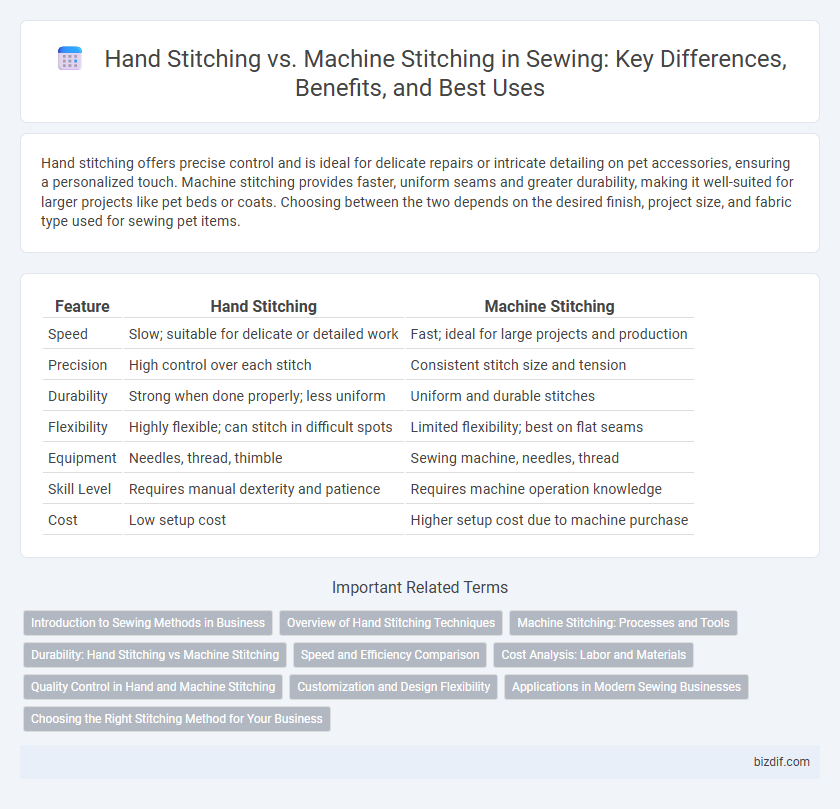Hand stitching offers precise control and is ideal for delicate repairs or intricate detailing on pet accessories, ensuring a personalized touch. Machine stitching provides faster, uniform seams and greater durability, making it well-suited for larger projects like pet beds or coats. Choosing between the two depends on the desired finish, project size, and fabric type used for sewing pet items.
Table of Comparison
| Feature | Hand Stitching | Machine Stitching |
|---|---|---|
| Speed | Slow; suitable for delicate or detailed work | Fast; ideal for large projects and production |
| Precision | High control over each stitch | Consistent stitch size and tension |
| Durability | Strong when done properly; less uniform | Uniform and durable stitches |
| Flexibility | Highly flexible; can stitch in difficult spots | Limited flexibility; best on flat seams |
| Equipment | Needles, thread, thimble | Sewing machine, needles, thread |
| Skill Level | Requires manual dexterity and patience | Requires machine operation knowledge |
| Cost | Low setup cost | Higher setup cost due to machine purchase |
Introduction to Sewing Methods in Business
Hand stitching offers precision and control essential for detailed or delicate fabrics, often preferred in bespoke tailoring and high-end garment production. Machine stitching delivers speed and consistency, making it ideal for large-scale manufacturing and meeting high-volume demands efficiently. Understanding the balance between these methods helps businesses optimize quality, cost, and production timelines in textile manufacturing.
Overview of Hand Stitching Techniques
Hand stitching techniques encompass a variety of methods such as running stitch, backstitch, slip stitch, and whip stitch, each serving different functional and decorative purposes. These techniques offer precise control for delicate fabrics, intricate details, and repairs, making them essential for tailoring, embroidery, and couture craftsmanship. Mastery of hand stitching contributes to the durability, aesthetic quality, and authenticity of handmade garments.
Machine Stitching: Processes and Tools
Machine stitching involves using a sewing machine to create consistent, even stitches at high speed, significantly increasing efficiency compared to hand stitching. Essential tools include the sewing machine itself, various needle types, presser feet, threads suited for different fabrics, and bobbins for thread supply. This process supports diverse stitch patterns like straight, zigzag, and decorative stitches, enabling precise and durable seams ideal for both garment construction and complex textile projects.
Durability: Hand Stitching vs Machine Stitching
Hand stitching offers precise control and can be reinforced for delicate fabrics, but machine stitching provides consistent strength and uniformity ideal for high-stress seams. Industrial sewing machines deliver durable stitches with enhanced tension control, reducing the risk of thread breakage compared to hand-sewn seams. For heavy-duty materials like denim or leather, machine stitching ensures greater resilience and longevity, outperforming hand stitching in durability.
Speed and Efficiency Comparison
Machine stitching significantly outpaces hand stitching in speed, completing seams in seconds versus the minutes or hours required by manual methods. Efficiency is enhanced by consistent stitch length and tension in machine stitching, reducing errors and rework. Hand stitching allows precision for delicate or intricate work, but it cannot match the volume and time savings of machine sewing in large-scale projects.
Cost Analysis: Labor and Materials
Hand stitching demands more labor hours, increasing overall labor costs compared to machine stitching, which significantly speeds up the process. Material costs for hand stitching can be lower initially, but frequent thread replacements and potential fabric wear may raise expenses over time. Machine stitching involves an upfront investment in equipment but offers consistent stitch quality and faster completion, reducing long-term labor costs and enhancing productivity.
Quality Control in Hand and Machine Stitching
Hand stitching offers superior precision in quality control, allowing artisans to carefully monitor tension and stitch placement for delicate fabrics or intricate designs. Machine stitching delivers consistent stitch length and strength, enhancing durability and uniformity, especially in mass production settings where speed and efficiency are critical. Quality control in hand stitching excels in customization, while machine stitching provides reliability and scalability.
Customization and Design Flexibility
Hand stitching offers unparalleled customization and design flexibility by allowing intricate, detailed embroidery and unique stitch variations tailored to individual fabric and style preferences. Machine stitching provides consistent, fast, and durable seams but limits the ability to create highly personalized designs or complex decorative patterns. Artisans often combine both methods to achieve precise craftsmanship while enhancing creative expression in custom garments.
Applications in Modern Sewing Businesses
Hand stitching offers precision and customization ideal for luxury fashion, alterations, and intricate embroidery, allowing artisans to deliver high-quality, unique products. Machine stitching provides speed and consistency essential for mass production, enabling modern sewing businesses to meet high-volume demands efficiently. Combining both techniques enhances product variety and quality, catering to diverse customer needs in contemporary garment manufacturing.
Choosing the Right Stitching Method for Your Business
Hand stitching offers precision and a traditional touch ideal for bespoke or delicate projects, while machine stitching provides speed and consistency essential for high-volume production. Selecting the right stitching method depends on factors such as fabric type, production scale, cost efficiency, and desired quality standards. Businesses aiming to optimize workflow should balance craftsmanship with automation to meet market demands effectively.
Hand stitching vs machine stitching Infographic

 bizdif.com
bizdif.com